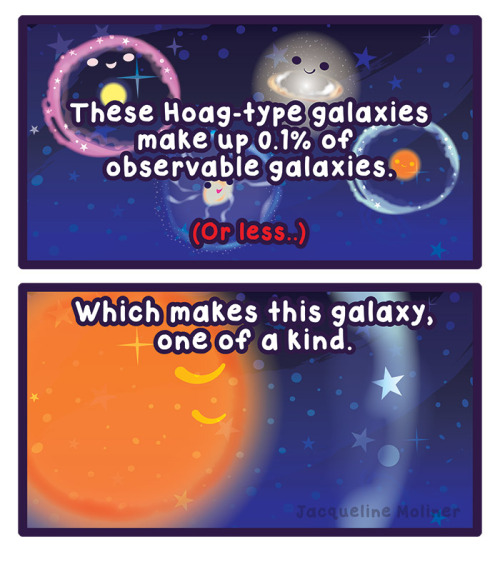Fibonacci You Crazy Bastard….
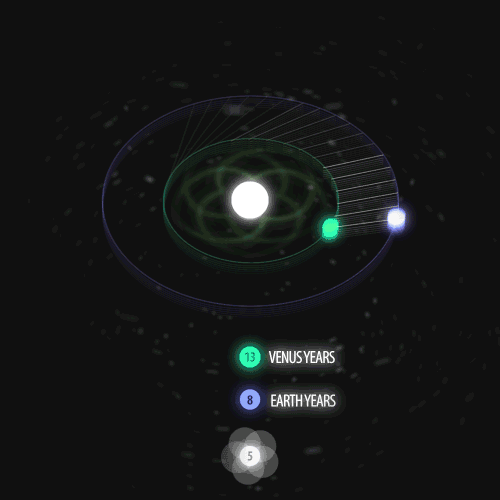
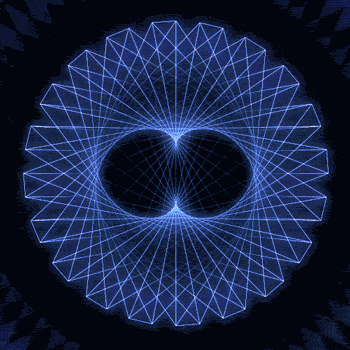
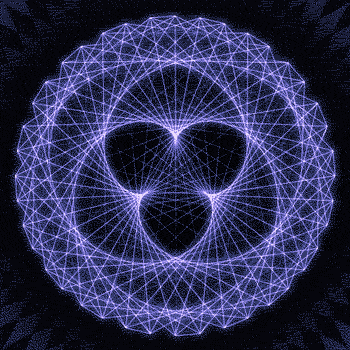


Fibonacci you crazy bastard….
As seen in the solar system (by no ridiculous coincidence), Earth orbits the Sun 8 times in the same period that Venus orbits the Sun 13 times! Drawing a line between Earth & Venus every week results in a spectacular FIVE side symmetry!!
Lets bring up those Fibonacci numbers again: 1, 1, 2, 3, 5, 8, 13, 21, 34..
So if we imagine planets with Fibonacci orbits, do they create Fibonacci symmetries?!
You bet!! Depicted here is a:
2 sided symmetry (5 orbits x 3 orbits)
3 sided symmetry (8 orbits x 5 orbits)
5 sided symmetry (13 orbits x 8 orbits) - like Earth & Venus
8 sided symmetry (21 orbits x 13 orbits)
I wonder if relationships like this exist somewhere in the universe….
Read the Book | Follow | Hi-Res -2- -3- -5- -8-
More Posts from Fillthevoid-with-space and Others

I imagine most people wanted to be astronauts when they learned it was a job they could have - I certainly did! And then I thought about it and realized podcasting about outer space was much less scary and much more achievable than becoming an astronaut, with the bonus of not having to wonder how hard I’d panic in an enclosed-yet-surrounded-by-vastness space. There have been a lot of people braver than me who went to space, and some of them went to space on long-term missions lasting months or a year, living on the International Space Station (or the historical equivalent, depending on when in history this happened). Learn what resources are available to ISS astronauts, and what risks there are out there (apart from the obvious ones).
Sorry I missed last week, but it was New Year’s and I don’t feel very guilty. Get excited about more space podcasts in 2018, though! Below the cut are my sources, music credits, a vocab list, and the transcript of this episode. I bolded any videos or sources that I mentioned in the podcast, if you’re looking for those specifically. Go ahead and suggest what you think I should research next by messaging me here, tweeting at me at @HDandtheVoid, or asking me to my face if you know me. Please subscribe on iTunes, rate it and maybe review it, and tell friends if you think they’d like to hear it!
(My thoughts on the next episode are more about astronauts, or I could go into the transit of Venus. I have a couple books about space I should really get into reading… The next episode will go up January 22nd.)
Glossary
free fall - the downward movement of an object that is due to the force of gravity alone.
gravity - the phenomenon which causes all things with mass to move towards each other. On the universal scale, this is caused by the warping of spacetime by objects with large mass, e.g. stars and planets, and is explained through Einstein’s theory of general relativity.
microgravity - the state of perpetual free fall in a gravity field.
orbit - the gravitationally curved trajectory of an object, e.g. the trajectory of a satellite around a planet.
Script/Transcript
Sources
Yuri Gagarin via NASA
Microgravity via NASA (Feb 2012)
The history of astronaut life via the Smithsonian Air and Space Museum
Menstruation in space via National Geographic (Apr 2016)
The Air We Breathe via the Smithsonian Environmental Research Center
Breathing Easy on the Space Station via NASA (Nov 2000)
Jay Perry: “the chemical-mechanical systems are much more compact, less labor intensive, and more reliable than a plant-based system.”
Astronaut’s Home Videos Show How to Cook in Space via Space.com (Mar 2013)
Astronaut Hygiene: How to Wash Your Hair In Space (Video) via Space.com (July 2013)
Interview with former astronaut Prof. Jeremy Hoffman via the University of Leicester
A day in the life aboard the International Space Station via NASA (2015)
Zvezda Module Overview via NASA
Food for Space Flight via Nasa (Feb 2004)
John Glenn via NASA (Feb 2012)
Crew From U.S., Russia and Japan Expands Space Population to Six via NASA (Dec 2017)
ISS blog with experiment updates via NASA
Astronaut daily life via ESA (Nov 2012)
The Skylab 4 Mutiny, 1973 via libcom.org (Apr 2004)
Carr: “On the ground, I don’t think we would be expected to work a 16-hour day for 85 days, and so I really don’t see why we should even try to do it up here.”
‘Space Oddity’ by Chris Hadfield via YouTube
Interview with astronaut Chris Hadfield via NPR (Oct 2013)
Col. Chris Hadfield: “The contrast of your body and your mind inside … essentially a one-person spaceship, which is your spacesuit, where you’re holding on for dear life to the shuttle or the station with one hand, and you are inexplicably in between what is just a pouring glory of the world roaring by, silently next to you — just the kaleidoscope of it, it takes up your whole mind. It’s like the most beautiful thing you’ve ever seen just screaming at you on the right side, and when you look left, it’s the whole bottomless black of the universe and it goes in all directions. It’s like a huge yawning endlessness on your left side and you’re in between those two things and trying to rationalize it to yourself and trying to get some work done.”
Excerpt from memoir by former astronaut Scott Kelly via the Sunday Morning Herald (Oct 2017)
Intro Music: ‘Better Times Will Come’ by No Luck Club off their album Prosperity
Filler Music: ‘Major Tom’ by Shiny Toy Guns off their album Major Tom.
Background Music: ‘Leaves’ by Patients aka Ben Cooper, who primarily releases music as Radical Face but also has at least three other bands or band names he’s working with/has released music as.
Outro Music: ‘Fields of Russia’ by Mutefish off their album On Draught

Mission Specialist Mae Jemison, the first African American woman in space, during mission STS-47 .
via reddit
NASA’s Hybrid Computer Enables Raven’s Autonomous Rendezvous Capability
ISS - International Space Station patch. March 21, 2017 A hybrid computing system developed at NASA’s Goddard Space Flight Center in Greenbelt, Maryland, is the enabling technology behind an ambitious experiment testing a relative navigation and autonomous docking capability known as Raven.
Image above: This panorama of the International Space Station was composed by piecing together images taken by Raven’s Visible Camera. These images were processed by a hybrid computing platform, SpaceCube 2.0. Image Credit: NASA. Developed by the Satellite Servicing Projects Division, or SSPD, the carry-on luggage-sized module was launched February 19 aboard SpaceX’s Dragon spacecraft, along with other experiments deployed outside the International Space Station on an experiment pallet. Raven is testing and maturing visible, infrared and lidar sensors and machine-vision algorithms; the module will bring NASA one step closer to realizing the groundbreaking autopilot capability that can be applied to many NASA missions for decades to come. Since NASA’s pre-Apollo days, the agency has successfully docked spacecraft while they speed through space. However, all operations involved humans who orchestrated the movements from the ground. Raven’s objective is to develop and mature technologies that ultimately will relieve human dependency and give spacecraft the ability to catch up with one another and dock autonomously in real time. “The Raven module is equipped with technology that lays the foundation for a relative navigation system,” said Goddard Director Christopher Scolese. “What some may not fully appreciate is the fact that Raven’s sensors could not do their job if it weren’t for another very effective technology called SpaceCube. The SpaceCube processor is the behind-the-scenes technology that is making this important demonstration possible.” SpaceCube is a reconfigurable, very fast flight computing platform that Goddard technologists first demonstrated during a relative navigation experiment on the Hubble Servicing Mission-4 in 2009. During the Raven experiment, the module’s “sensors serve as the eyes. SpaceCube acts as the brain, analyzing data and telling components what to do,” said Ben Reed, deputy division director of SSPD. The “eyes” and the “brain” together create the autopilot capability. Since its initial development, SpaceCube has evolved into a family of flight computers all distinguished by their computing speed, which is 10 to 100 times faster than the commonly used spaceflight processor — the RAD750. Though the RAD750 is immune to the adverse effects of radiation, it is slow and many generations behind the computing speed of commercial processors. SpaceCube processors achieve their data-crunching prowess because Goddard technologists married radiation-tolerant integrated circuits, which are programmed to execute specific computing jobs simultaneously, with algorithms that detect and fix radiation-induced upsets in collected data. Consequently, these hybrid systems are nearly as reliable as the RAD750, yet orders-of-magnitude faster, capable of executing complex computations once limited to ground-based systems.
Image above: This image shows the Defense Department’s experiment pallet, STP-H5, hanging at the end of Canada’s robotic arm during installation on the outside of the International Space Station. Image Credit: NASA. During its two-year stay on the space station, Raven will sense incoming and outgoing visiting space station spacecraft, feeding the data it “sees” to SpaceCube 2.0, one in the family of SpaceCube products. SpaceCube then runs a set of pose algorithms, or a set of instructions, to gauge the relative distance between Raven and the spacecraft it is tracking. Then, based on these calculations, SpaceCube 2.0 autonomously sends commands that swivel the Raven module on its gimbal or pointing system to keep the sensors trained on the vehicle, while continuing to track it. While all this is transpiring, NASA operators on the ground monitor Raven’s technologies, paying close attention to how they function as a system and making necessary adjustments to increase Raven’s tracking abilities. “Tracking spacecraft with this system is only possible because we have SpaceCube,” said SSPD Avionics Technology Lead and SpaceCube Lead Engineer David Petrick, who has won prestigious awards for his work on the processor. “This type of operation requires fast computing.” Raven’s foundational technologies will be applied to future missions. For example, Restore-L, which also will use SpaceCube 2.0, will rendezvous with, grasp, refuel and relocate Landsat 7 when it launches in 2020. SpaceCube 2.0, however, isn’t the only processor now at work on the space station’s external experiment pallet sponsored by the Department of Defense’s Space Technology Program. SpaceCube 1.0 is being used as the communication interface between the space station’s data services and multiple experiments on the pallet. In addition, a miniaturized version of SpaceCube 2.0 — the SpaceCube Mini — is operating two NASA and U.S. Defense Department experiments. NASA also is testing two other miniature computers, developed with the University of Florida. These models are mostly equipped with commercial parts. For other technology news, go to https://gsfctechnology.gsfc.nasa.gov/newsletter/Current.pdf Related links: Raven: https://sspd.gsfc.nasa.gov/Raven.html SpaceCube: https://spacecube.gsfc.nasa.gov/ Space Station Research and Technology: https://www.nasa.gov/mission_pages/station/research/index.html International Space Station (ISS): https://www.nasa.gov/mission_pages/station/main/index.html Images (mentioned), Text, Credits: NASA Goddard Space Flight Center/Lori Keesey/Lynn Jenner. Greetings, Orbiter.ch Full article

The Elephants Trunk in IC 1396 : Like an illustration in a galactic Just So Story, the Elephants Trunk Nebula winds through the emission nebula and young star cluster complex IC 1396, in the high and far off constellation of Cepheus. Of course, the cosmic elephants trunk is over 20 light-years long. This composite was recorded through narrow band filters that transmit the light from ionized hydrogen, sulfur, and oxygen atoms in the region. The resulting image highlights the bright swept-back ridges that outline pockets of cool interstellar dust and gas. Such embedded, dark, tendril-shaped clouds contain the raw material for star formation and hide protostars within the obscuring cosmic dust. Nearly 3,000 light-years distant, the relatively faint IC 1396 complex covers a large region on the sky, spanning over 5 degrees. via NASA
js
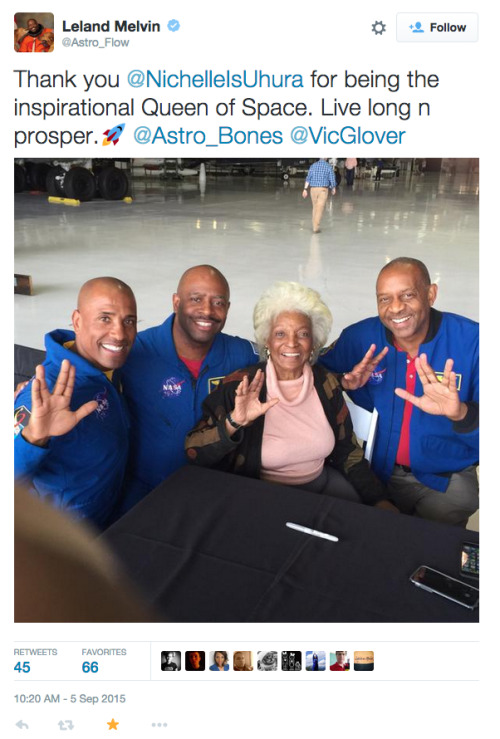
Why Star Trek matters.

The last look before her descent in fire…
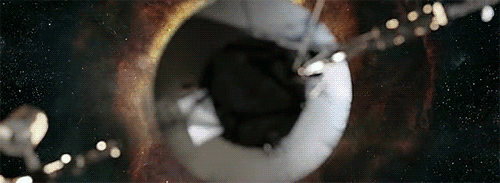
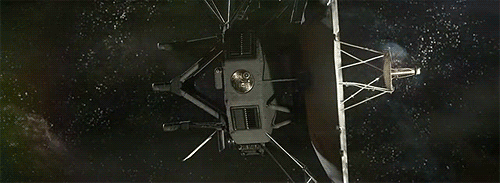
Biggest Scientific Breakthroughs of 2013
From intergalactic neutrinos and invisible brains, to the creation of miniature human “organoids”, 2013 was an remarkable year for scientific discovery. Here are some of the biggest scientific breakthroughs, innovations and advances of 2013.
Voyager I Leaves the Solar System
Escaping the solar system is no mean feat. For 36 years, NASA’s Voyager 1 spacecraft has putting distance between itself and the Sun at speeds approaching 11 miles per second. At a pace like that, scientists knew Voyager was approaching the fringes of the heliosphere that surrounds and defines our solar neighborhood – but when would it break that barrier? When would it make the leap to interstellar space? After months of uncertainty, NASA finally made the news official this September. “Voyager 1 is the first human-made object to make it into interstellar space” said Don Gurnett, lead author of the paper announcing Voyager’s departure; “we’re actually out there.”
The Milky Way is Brimming with Habitable Worlds
Planet-hunting scientists announced in November that 22% of sunlike stars in the Milky Way are orbited by potentially habitable, Earth-size worlds. This remarkable finding suggests there could be as many as two-billion planets in our galaxy suitable for life — and that the nearest such planet may be only 12 light-years away. Is Earth 2.0 out there? With figures like that, it’s hard to imagine otherwise. Who knows – with all the Kepler data we’ve got to sift through, there’s a chance we’ve already found it.
Curiosity Confirms Mars Was Once Capable of Harboring Life
In March, NASA scientists released perhaps the most compelling evidence to date that the Red Planet was once capable of harboring life. Earlier this year, Curiosity drilled some samples out of a sedimentary rock near an old river bed in Gale Crater. This geological area used to feature a series of stream channels, leaving behind finely grained bedrock indicative of previously wet conditions. Using the rover’s onboard instrumentation, NASA scientists analyzed these samples to detect some of the critical elements required for life, including sulfur, nitrogen, hydrogen, oxygen, phosphorus, and carbon. The rover is currently on a trek to its primary scientific target – a three-mile-high peak at the center of Gale Crater named Mount Sharp – where it will attempt to further reinforce its findings.
Researchers Detect Neutrinos from Another Galaxy
By drilling a 1.5 mile hole deep into an Antarctic glacier, physicists working at the IceCube South Pole Observatory this year captured 28 neutrinos, those mysterious and extremely powerful subatomic particles that can pass straight through solid matter. And here’s the real kicker: the particles likely originated from beyond our solar system – and possibly even our galaxy. "This is a landmark discovery,“ said Alexander Kusenko, a UCLA astroparticle physicist who was not involved in the investigation, "possibly a Nobel Prize in the making.”
NASA Discovers “A Previously Unknown Surprise Circling Earth”
NASA’s recently deployed Van Allen probes — a pair of robotic spacecraft launched in August 2012 to investigate Earth’s eponymous pair of radiation belts — turned out out some very unexpected findings in February, when they spotted an ephemeral third ring of radiation, previously unknown to science, surrounding our planet.
Human Cloning Becomes a Reality
A scientific milestone 17 years in the making, researchers announced in May that they had derived stem cells from cloned human embryos.The controversial technology could lead to new treatments for diseases like Parkinson’s and diabetes — while bringing us one step closer to human reproductive cloning.
Giant “Pandoravirus” Could Redefine Life as we Know it
Scientists in July announced the discovery of a pair of viruses that defy classification. Bigger and more genetically complex than any viral genus known to science, these so-called “pandoraviruses” could reignite a longstanding debate over the classification of life itself.
Brain-to-Brain Interfaces Have Arrived
Back in February, researchers announced that they had successfully established an electronic link between the brains of two rats, and demonstrated that signals from the mind of one could help the second solve basic puzzles in real time — even when those animals were separated by thousands of miles. A few months later, a similar connection was established between the brain of a human and a rat. Just one month later, researchers published the results of the first successful human-to-human brain interface. The age of the mind-meld, it seems, is near at hand.
There is Life at the End of the World
There is life in Lake Whillans. For millions of years, the small body of liquid water has lurked hundreds of meters below Antarctica’s Ross Ice Shelf, sealed off from the outside world and the scientists who would explore its subglacial depths. Earlier this year, a team of researchers led by Montana State University glaciologist John Priscu successfully bored a tunnel to Whillans and encountered life, making Priscu and his colleagues the first people in history to discover living organisms in the alien lakes at the bottom of the world.
Doctors Cure HIV in a Baby Born With the Disease
In a monumental first for medicine, doctors announced in March that a baby had been cured of an HIV infection. Dr. Deborah Persaud, who presented the child’s case at the 20th annual Conference on Retroviruses and Opportunistic Infection, called it “definitely a game-changer.”
Newly Discovered Skulls Could Prune Humans’ Evolutionary Tree
An incredibly well-preserved, 1.8-million-year-old skull from Dmanisi, Georgia suggests the evolutionary tree of the genus Homo may have fewer branches than previously believed. In a report published in October, a team led by Georgian anthropologist David Lordkipanidze writes that it is “the world’s first completely preserved hominid skull.” And what a skull it is. When considered alongside four other skulls discovered nearby, it suggests that the earliest known members of the Homo genus (H. habilis, H.rudolfensis and H. erectus) may not have been distinct, coexisting species, at all. Instead, they may have been part of a single, evolving lineage that eventually gave rise to modern humans.
Neuroscientists Turn Brains Invisible
Gaze upon the stunning effects of CLARITY, a new technique that enables scientists to turn brain matter and other tissues completely transparent. It’s been hailed as one of the most important advances for neuroanatomy in decades, and it’s not hard to see why.
[source | gifs → galaxyclusters]
This is an article from last year, but still very exciting news! I wonder how far it’s progressed since?

The venerable Voyager 1 spacecraft. Still impressing after all these years.

Why do the Sun and Moon move the way they do? What’s up with that? Orbits? What? It’s a short but snug little episode here about the Sun and the Moon and how they look from Earth as they zoom across the sky.
Below the cut are my sources, music credits, a vocab list, the transcript of this episode, a composite image of the different phases of the Moon, and a list of the different names for the full moons through the course of a year. Let me know what you think I should research next by messaging me here, tweeting at me at @HDandtheVoid, or asking me to my face if you know me in real life. And please subscribe to the podcast on iTunes, rate it or review it, and maybe tell your friends about it if you think they’d like to listen!
(My thoughts on the next episode, because I still haven’t found the time to cover them, are the Voyager golden records, space race history, the transit of Venus, the Moon landing, or Edmond Halley. Let me know by the 6th and I’ll hopefully have the next podcast up on October 16th.)
Glossary
blue moon - when you get two full moons in one calendar month. An older definition is when you get 4 full moons in a season, the third moon is called the ‘blue moon.’
ecliptic - the path of the Sun over the course of a year.
prograde - when a planet spins from east to west.
retrograde - when a planet spins from west to east.
spaghettification - when extreme tidal forces pull an object apart in space.
Script/Transcript
Sources
Rising and setting times of the Sun on Earth via Cornell University
Seasons on Earth via Cornell University
Lunar phases and the Moon’s relationship to the Sun via Harvard
Tides via Hyperphysics
Tidal forces equation via AstronomyOnline.org
Tidal forces and spaghettification via NASA handout
Lunar phases composite via Fred Espenak
Names of the different full moons throughout the year via EarthSky.org
Blue moons via EarthSky.org
Intro Music: ‘Better Times Will Come’ by No Luck Club off their album Prosperity
Filler Music: ‘See The Constellation’ by They Might Be Giants off their album Apollo 18
Outro Music: ‘Fields of Russia’ by Mutefish off their album On Draught
-
 tylirene liked this · 2 months ago
tylirene liked this · 2 months ago -
 dreamconsumer reblogged this · 2 months ago
dreamconsumer reblogged this · 2 months ago -
 chryso-poeia liked this · 2 months ago
chryso-poeia liked this · 2 months ago -
 hislittlestar liked this · 2 months ago
hislittlestar liked this · 2 months ago -
 siren-nereide reblogged this · 2 months ago
siren-nereide reblogged this · 2 months ago -
 siren-nereide liked this · 2 months ago
siren-nereide liked this · 2 months ago -
 drosselmeyertoade liked this · 2 months ago
drosselmeyertoade liked this · 2 months ago -
 mika3lmy3r2 liked this · 2 months ago
mika3lmy3r2 liked this · 2 months ago -
 the-seventh-magpie reblogged this · 2 months ago
the-seventh-magpie reblogged this · 2 months ago -
 tokaiju reblogged this · 2 months ago
tokaiju reblogged this · 2 months ago -
 tokaiju liked this · 2 months ago
tokaiju liked this · 2 months ago -
 nicolas-lovelace liked this · 2 months ago
nicolas-lovelace liked this · 2 months ago -
 danephere reblogged this · 2 months ago
danephere reblogged this · 2 months ago -
 danephere liked this · 2 months ago
danephere liked this · 2 months ago -
 justpostsyeet liked this · 3 months ago
justpostsyeet liked this · 3 months ago -
 elirium liked this · 3 months ago
elirium liked this · 3 months ago -
 steadychaosdaze liked this · 3 months ago
steadychaosdaze liked this · 3 months ago -
 little-big-batbag reblogged this · 3 months ago
little-big-batbag reblogged this · 3 months ago -
 little-big-batbag liked this · 3 months ago
little-big-batbag liked this · 3 months ago -
 vampiregokudera reblogged this · 3 months ago
vampiregokudera reblogged this · 3 months ago -
 vampiregokudera liked this · 3 months ago
vampiregokudera liked this · 3 months ago -
 eeby liked this · 3 months ago
eeby liked this · 3 months ago -
 vovchik7777 liked this · 4 months ago
vovchik7777 liked this · 4 months ago -
 onewithbliss liked this · 5 months ago
onewithbliss liked this · 5 months ago -
 ctzenb-u reblogged this · 7 months ago
ctzenb-u reblogged this · 7 months ago -
 emariialex reblogged this · 7 months ago
emariialex reblogged this · 7 months ago -
 kissmeagainarthas liked this · 7 months ago
kissmeagainarthas liked this · 7 months ago -
 shadowedseas reblogged this · 8 months ago
shadowedseas reblogged this · 8 months ago -
 hodudghejs liked this · 8 months ago
hodudghejs liked this · 8 months ago -
 8orone reblogged this · 8 months ago
8orone reblogged this · 8 months ago -
 dualcasterjay liked this · 8 months ago
dualcasterjay liked this · 8 months ago -
 ratsconfusion liked this · 10 months ago
ratsconfusion liked this · 10 months ago -
 ave-aria liked this · 10 months ago
ave-aria liked this · 10 months ago -
 silliestlittlegoblin liked this · 11 months ago
silliestlittlegoblin liked this · 11 months ago -
 cinder-wolf reblogged this · 1 year ago
cinder-wolf reblogged this · 1 year ago -
 cinder-wolf liked this · 1 year ago
cinder-wolf liked this · 1 year ago -
 cafehearts reblogged this · 1 year ago
cafehearts reblogged this · 1 year ago -
 cafehearts liked this · 1 year ago
cafehearts liked this · 1 year ago -
 roseraded reblogged this · 1 year ago
roseraded reblogged this · 1 year ago -
 beachchairbookworm liked this · 1 year ago
beachchairbookworm liked this · 1 year ago -
 not-kashy liked this · 1 year ago
not-kashy liked this · 1 year ago -
 pauloventurablog liked this · 1 year ago
pauloventurablog liked this · 1 year ago -
 olgaaanitaa liked this · 1 year ago
olgaaanitaa liked this · 1 year ago
A podcast project to fill the space in my heart and my time that used to be filled with academic research. In 2018, that space gets filled with... MORE SPACE! Cheerfully researched, painstakingly edited, informal as hell, definitely worth everyone's time.
243 posts



